Note: Amazon Web Services (AWS) is another guest post by Ahmed Zeeshan, HCIE# 11848. Many thanks to him for contributing to our blog and sharing his expert insight on AWS services.
In case you have any queries or would like to connect with Ahmed, you can drop him a message on his LinkedIn.
Amazon Web Services – Top 10 AWS Services
Amazon Web Services (AWS) – The Market Leader
Amazon Web Services is currently world’s leading Cloud Service Provider. It came into existence in 2002 and remained the only cloud service provider for many years till in 2009 when Google (Google Cloud Platform) started providing cloud based solutions. Microsoft Azure, who is currently considered the biggest competitor of Amazon didn’t step into this domain till 2010. However, the pace with which azure is occupying the cloud industry it seems they may over take Amazon as leading cloud service provider in next few years.
As per the latest stats, AWS is leading the industry with 32.4% of the market, Azure has 17.6% of market, Google Cloud has 6%, Alibaba Cloud close behind at 5.4%, and other clouds (Huawei, oracle, openstack, salesforce) with 38.5% [1], [2].
Also, the company’s current revenue is $502.19 billion. In 2021, the company’s sales were $469.82 billion, an increase from $386.06 billion in 2020. If you want to know more about the company analysis then you can read the Amazon SWOT analysis.

AWS – A Success Story!
Apart from being the oldest cloud architect, AWS is widely trusted by the customers because of having wide range of platform configuration options, monitoring and policy features and most importantly security and reliability feature. If we talk about the biggest industrial giants who are using services of AWS, we will find a long list.
I am listing a few of them below just to give you an idea.
NASA, ESA, Shell, Unilever, Kellogg’s, Siemens, Netflix, Philips, Twitter, BBC, Adobe, ESPN, BAIDU, LINKEDIN, TWITCH, Quora, Spotify, Alcatel-Lucent, Expedia, Nintendo, EA Sports etc constitute the huge list of industrial giants who are currently using different AWS cloud services [3].
According to Amazon, the number of active AWS users exceeds 1,000,000.

Another reason behind the great success of AWS is because of success of its parent company Amazon, which is the one of the leading online retailers worldwide and the leading e-retailer in the United States (net sales amounted to over 280.5 billion U.S. dollars) [4].
If we look at the official stats provided by AWS, we can see that in last 5-6 years, AWS has generated a lot of revenue i.e. 10.219 Billion USD in Q1 of 2020 as quarterly revenue and 35.026 in year 2019 as yearly revenue.
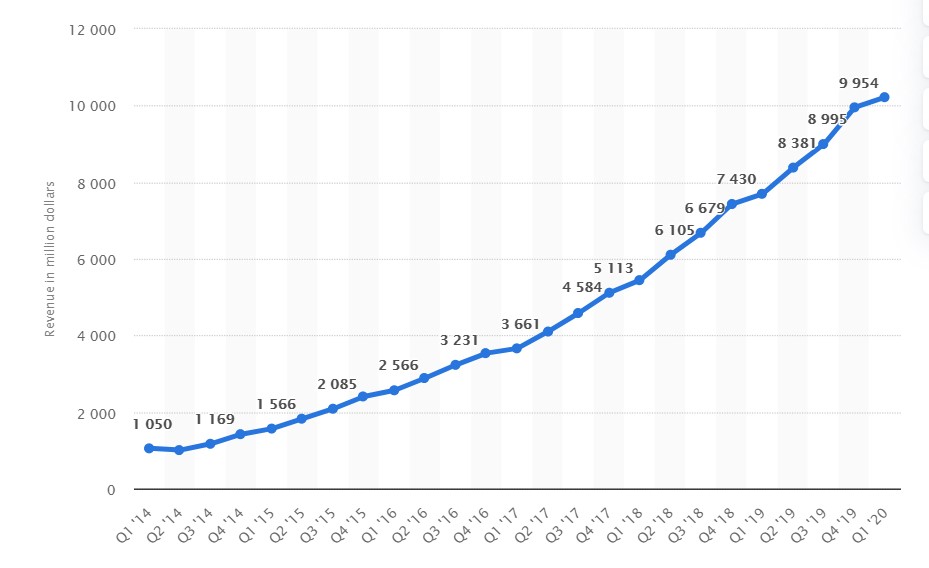
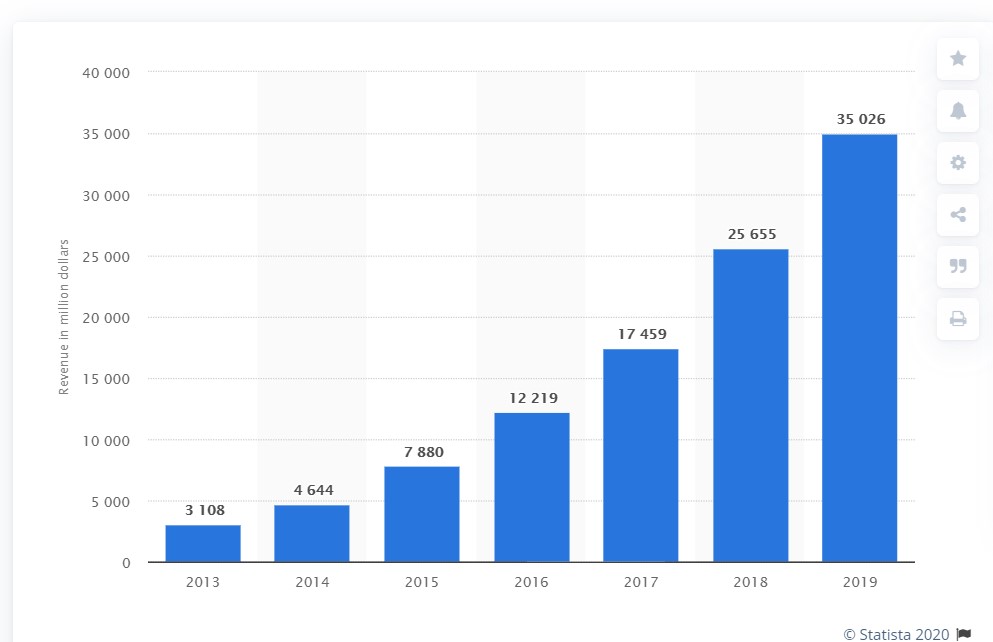
According to Intricately, the top ten AWS users based on EC2 monthly spend are as follows.
- Netflix: $19 million
- Twitch: $15 million
- LinkedIn: $13 million
- Facebook: $11 million
- Turner Broadcasting: $10 million
- BBC: $9 million
- Baidu: $9 million
- ESPN: $8 million
- Adobe: $8 million
- Twitter: $7 million
World Wide Presence of AWS
Currently AWS has its foot prints across 245 countries having around over 24 regions* and 76 Availability Zones* with announced plans for nine more Availability Zones and three more AWS Regions in Indonesia, Japan, and Spain. It has a total of 216 Points of Presence and 97 Direct Connect Locations* [2].
*Regions – Independent geographic Area
*Availability Zone – Multiple isolated locations/datacenters within a region.
By placing resources in separate AZ, we can protect our application/website from services disruptions impacting a single location.
*Direct Connect – Using AWS Direct Connect, you can establish private connectivity between AWS cloud and your datacenter/office/co-location environment. It helps reducing your network costs, increasing bandwidth throughput and providing a more consistent network experience than Internet-based connections.

AWS Services
As per stats compiled on Amazon official website till date, Amazon Web Services is offering more than 212 Cloud based services mainly for Compute, Databases, Networking and Content Delivery, Management, Analytics, Containers, IoT, application integration and security, identity and compliance etc.
In this article, I will be briefly covering a few of the major AWS services. My plan is to list down the top ten AWS services in 2020. My opinion will be based on the market analysis I have done till now and to some extent on the basis of devices I like the most because of their distinct and noble features. You may find my opinion inclined more towards services related to Networks (As I am a Networking guy) 🙂
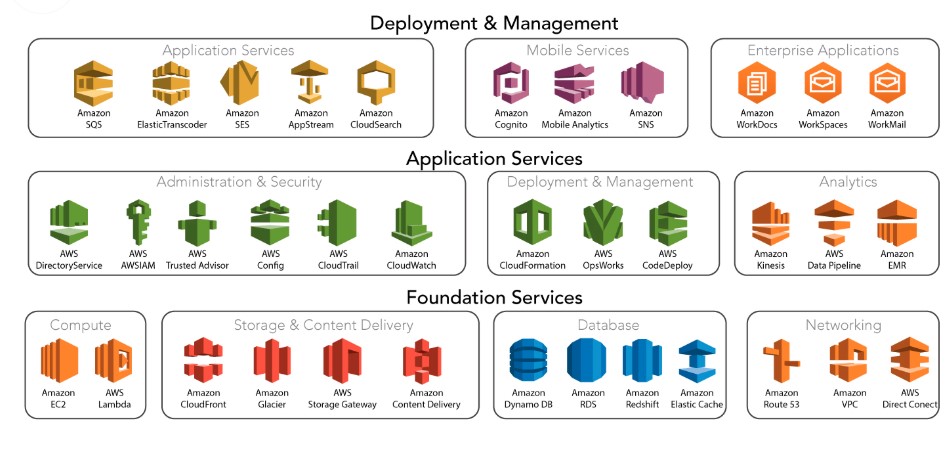
1. Amazon Elastic Compute Cloud (Amazon EC2)
It is one of the most important AWS (Compute) service and this is the reason I have mentioned it on the top.
Amazon Elastic Compute Cloud (Amazon EC2) is a web service that provides highly secure, resizable compute capacity in the cloud. It provides users with a reliable and scalable On Demand Infrastructure. It is widely used by customers because of having simple and quick options to be selected from preconfigured software on Amazon Machine Images (AMIs) from AWS market place and getting started without any delay.EC2 Amazon console can be launched with a single click & its installation is also quite simple.
Features of EC2
- More workloads including SAP, HPC, Machine Learning, Windows, and many more run on AWS than on any other cloud
- 300+ instance types to help optimize the cost and performance of your workloads
- Available with choice of processor, storage and networking options, operating system, and purchase model.
I have already listed top ten EC2 based users on the basis of revenue from which you can realize its significance and importance.
Moreover, just in case you further want to see how much value AWS EC2 is adding in organizations, then kindly go through these two case studies of Shopback [6] and Coursera [7] where you will realize how much value AWS EC2 is adding in different organizations and how they are taking benefit from it.
2. Lambda
AWS Lambda is an awesome server-less compute service. It allows users to run their code without provisioning or managing servers. Users only need to upload their code on lambda and it is executed whenever needed and scales automatically as per the size of workload.
Here Users are charged only when the code is executed (you are charged for every 100ms your code executes and the number of times your code is triggered). Users are not charged when their code is not running.
Lambda is in use in industries widely for different purposes like for image processing (it can process images loaded in S3 and creates thumbnails), analsysis of social media data. Moreover, it can be used in the form of server less back-ends to handle web, mobile, Internet of Things (IoT), and 3rd party API requests. It can be used to built strong web-applications without worrying for the administration of servers. It can also be used to preprocess data before feeding it to your machine learning model.
I am listing down a few famous industrial giants who are using AWS Lambda for different purposes:
- Seatle times: Using lambda for resizing images to be viewed then on different devices
- Localytics: Localytics processes billions of data points in real-time, and uses Lambda to process historical and live data stored in S3 or streamed from Kinesis.
- AIble: Using Lambda for managing machine learning workloads via minimal operational cost.
- Bustle: Using lambda for its Bustle Ios App so that engineers can focus on bringingout new features without worrying for infrastructure management.
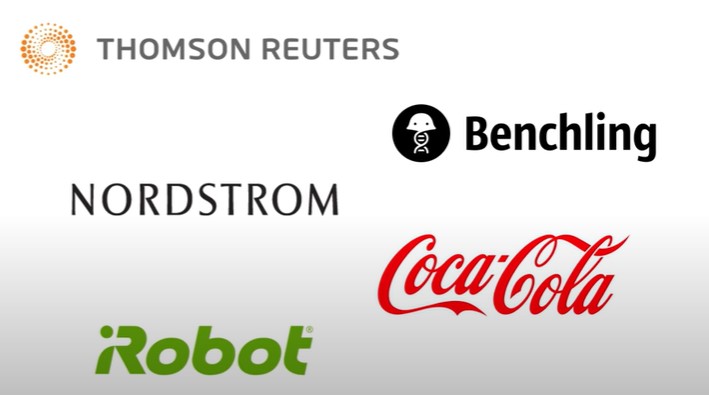
3. Cloud Watch
This is my favorite AWS Service. It is Network Management System (NMS) provided by Amazon to its customers so that they can monitor different KPIs for the services they have purchased from AWS. It collects data from the AWS resources in the form of logs, metrics, events which can be used for fault management, performance management as well as for different troubleshooting purposes.



4. Virtual Private Cloud
VPC stands for Virtual Private Cloud. It enables customers to launch AWS resources in a virtual network they have defined. This virtual network resembles their own traditional network in the data centre with additional benefits of scalable infrastructure of AWS. It allows customers to have complete control over all the resources including IP pool selection, routing tables, network gateways. It provides customers with privilege to use both IPV4 as well as IPV6 addresses for the resources. Here you can allocate public addresses to few internet facing nodes as well as private addresses to the internal nodes. Natting also can be done (using NAT gateways) and connectivity of one VPC can be done with another VPC using different methodologies (VPC Peering etc).
Whenever we refer to VPC, we see a few commonly used terms, which I will briefly mention below:
- Security groups: It allows users to set inbound as well as outbound rules and guidelines for the access of network.
- Internet gateway: A service which allows different instances in public subnet to access the internet
- Nat Gateways: They are used to access internet
- Elastic IP’s: Fixed static IPs assigned to different resources in VPC
- VPC Endpoints: It enables private connectivity to services hosted in AWS, from within your VPC without using an Internet Gateway, VPN, Network Address Translation (NAT) devices, or firewall proxies.

5. Route 53
One of my favorite AWS service is Route 53. It is the Domain Name system webservice provided by AWS. It is a highly available, scalable , reliable(handle million of queries) ,cost-effective (pay as you go and pay for what you use), low latency and secure DNS web service due to which it is in use by many famous customers like Coursera, Medium, Reddit, Instacart, Airbnb Etc. It also offers Domain Name Registration i.e. You can purchase and manage domain names such as abc.com and Amazon Route 53 will automatically configure DNS settings for your domains. It provides its customer with different routing policies like failover, geo location, latency based routing, geo proximity route policy, etc which enables it to have features mentioned above.
You can further read about these features from AWS official website.

6. Elastic Loadbalancers
It is one of the most used AWS service especially because of its ability to make customer’s network highly available, scalable and reliable. Elastic Load Balancers distribute downstream traffic across multiple target services/offerings which can be EC2 instances, Containers, Lamba services and even IP addresses (single or even in multiple availability zones). They redirect traffic to other instances even if they observe them to be unhealthy and distribute the load between healthier ones. AWS has three kind of loadbalancers mentioned below:
- Classic Load Balancers
- Application Loadbalancers
- Network Loadbalancers
Generally Classic load-balancers are not recommended to be used now. Experts suggest using Application and Network Loadbalancers.
7. Amazon Simple Storage Service (S3)
It provides users with secure, durable and highly available (99.999999999%) cloud storage. In S3 you can store a large amount of data at a very low cost. It is ideal for backup and archival of critical data. Here customers can store unlimited size of data.
Now, I am going to mention the best thing about S3 i.e. its storage classes. Amazon S3 offers a wide range of storage classes designed for different use cases and customer requirements. I am listing them below one by one with their usage and benefits:
- Amazon S3 Standard (S3 Standard): It is general purpose S3 storage S3 Standard for general-purpose storage of frequently accessed data.
- Amazon S3 Intelligent-Tiering (S3 Intelligent-Tiering): It is used for data with unknown or changing access patterns.
- S3 Standard-Infrequent Access (S3 Standard-IA): it is used in case customers want to use data very infrequently. For example if a customer is using it for storing some data which you have to use only weekly or few times in a month.
- S3 One Zone-Infrequent Access (S3 One Zone-IA): S3 One Zone-IA stores data in a single AZ and costs 20% less than S3 Standard-IA.
- Amazon S3 Glacier (S3 Glacier): it is the cheapest S3 storage class but here data retrieval may take up to 3-5 hours. It is ideal for data archiving.
You can refer to the case studies mentioned on AWS official websites of customers Georgia pacific [8], nasdaq [9], syco [10] and Nielsen [11] who are utilizing different S3 storage classes
8. Amazon Relational Database Service (Amazon RDS)
Amazon Relational Database Service (Amazon RDS) is a web service that helps customers to configure an easy to setup, easy to operate and a very scalable relational database on AWS cloud.
RDS allows customers to focus more on application and the schema and manages itself tedious administrative tasks like backups, scaling, patching and replications etc.
Amazon RDS is available on different database instance types comprising general purpose, memory optimized and performance optimized and can be used with six famous widely used database engines namely Amazon Aurora, MySQL, PostgreSQL, MariaDB, Oracle SQL and SQL Server and Amazon Aurora.

Famous RDS Partners are Apps Associates [13] and rackspace [14].
9. DynamoDB
It is AWS NoSQL Offering. Unlike RDS it does not provide other NoSQL software options. It provides users with consistent, single digit milliseconds latency, scalable database. It is heavily used in IOT, mobile, web,gaming, ad-tech and many other applications because of having a very flexible and very reliable database model. It can replace mangoDb, oracle NoSql and cassandra Db.
It was a difficult decision for me to select the last Service because I like AWS CloudFront, Elastic Cache, Beanstalk and ECS a lot and rate them very high, but I am listing CloudFront on number 10 because of its huge customer base in gaming, e-commerce, social media, security, enterprise, public sectors and most importantly media and entertainment industry.
10. Amazon CloudFront
Amazon CloudFront is a global Content Delivery Network (CDN) service offered by AWS. It helps developers and businesses to deliver content to the end customers globally using a very low latency, high transfer speed using a global network of Edge Locations. CloudFront works seamlessly with services including AWS Shield for DDoS mitigation, Amazon S3, Elastic Load Balancing or Amazon EC2 as origins for your applications, and Lambda@Edge to run custom code closer to customers’ users and to customize the user experience.
Lastly, if you use AWS origins such as Amazon S3, Amazon EC2 or Elastic Load Balancing, you don’t pay for any data transferred between these services and CloudFront [12]. AWS Free Tier includes 50GB data transfer out, 2,000,000 HTTP and HTTPS Requests with Amazon CloudFront.
Below mentioned is the list of different customers using cloud front for different purposes.
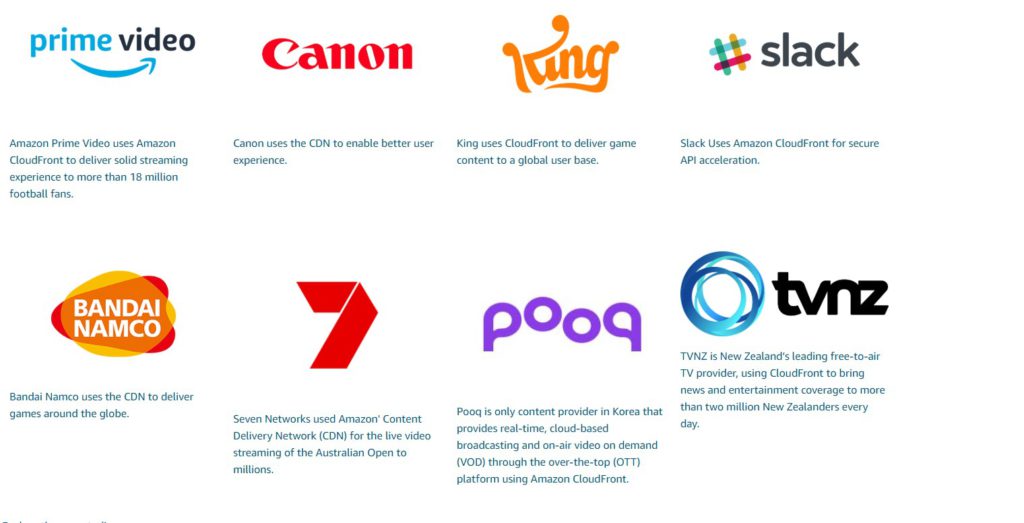
References:
[2]. https://aws.amazon.com/about-aws/global-infrastructure/
[3]. https://aws.amazon.com/solutions/case-studies
[4]. https://www.statista.com/statistics/266282/annual-net-revenue-of-amazoncom/
[6]. https://aws.amazon.com/solutions/case-studies/shopback-case-study/?did=cr_card&trk=cr_card
[7]. https://aws.amazon.com/solutions/case-studies/coursera/?pg=CRHuB
[8]. https://aws.amazon.com/solutions/case-studies/georgia-pacific/
[9]. https://aws.amazon.com/solutions/case-studies/nasdaq-case-study/
[10]. https://aws.amazon.com/solutions/case-studies/sysco/
[11]. https://aws.amazon.com/solutions/case-studies/nielsen-case-study/
[12]. https://www.amazonaws.cn/en/cloudfront/
[13]. https://pages.awscloud.com/GLOBAL-acq-IPC-pcc-migration-appsassociates-july-2019-learn.html
Ahmed Zeeshan
Latest posts by Ahmed Zeeshan (see all)
- How I Cracked My CISSP? - July 21, 2023
- Amazon Web Services (AWS) – The Market Leader - August 2, 2020
- My Journey to Huawei HCIE 🙂 - March 15, 2020
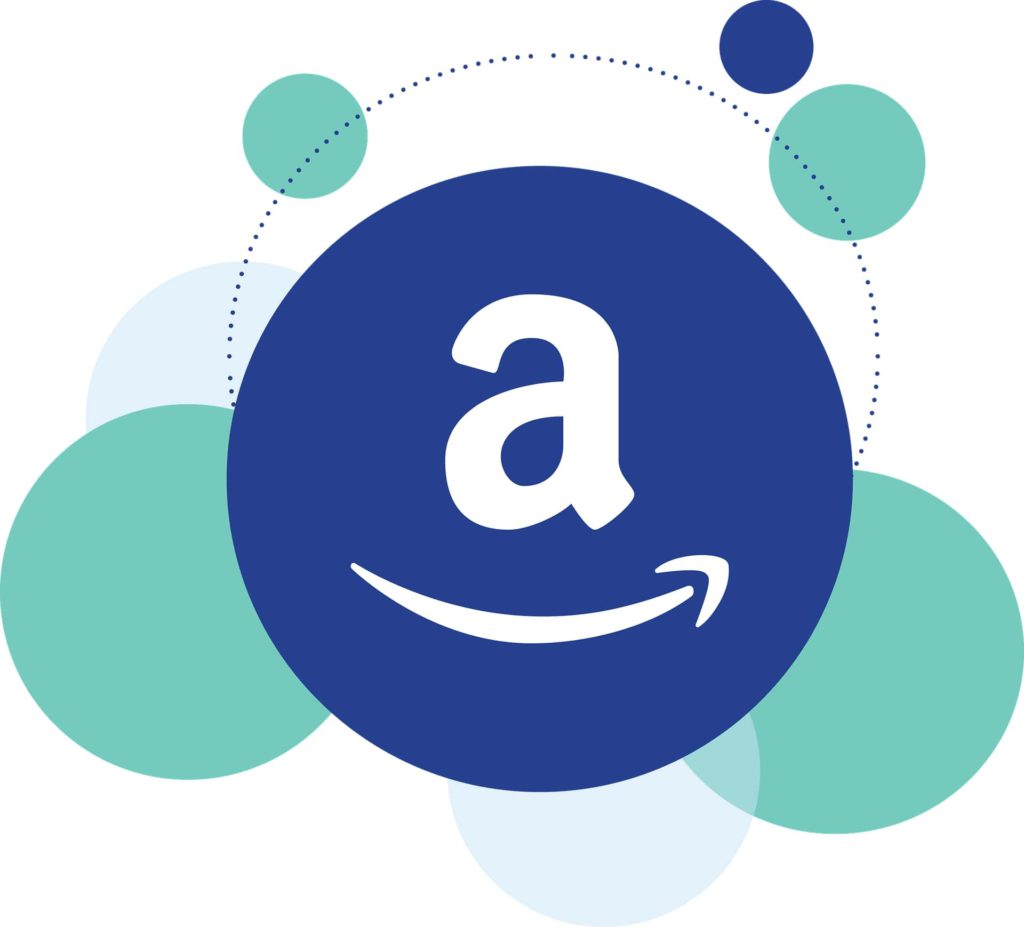
Good Content
Good to read . Quite simple and easy to understand the cloud computing
Very informational and brilliant writing
Thank you very much indeed for sharing this important article.Very Informative and it seems well researched and detailed.
Thanks for the kind words
Excellent read. Very informational and elaborate
Keep it up Zeeshan
thanks for the kind words
Nice article
Many Thanks for the feedback. Please feel free to contact me in case you have any queries
Thanks for the kind words
Nice read, services were covered well for introductory purpose
Thanks for the feedback, Yeah in the first phase i tried to cover the basics and how AWS has captured the industry currently.
Its such a wonderfully compiled article. It seems aws may keep leading the market for next 5 years but afterwards azzure will overtake it
Many Thanks for the feedback.Yes, you are right I also feel that Azzure may take over AWS in coming years mainly because of its huge presence in on premises datacenters. They are offering their customers a very cheap package to shift on-premises datacenters to cloud and it is working for them until now
Detailed Analysis By the tech Guru. Nice work done .
I am glad you found it to be helpful
Thanks for the kind words
Excellent article, keep it up Ahmed Zeeshan 🙂
Thanks for the kind words
Good analysis and insight into AWS, very informative, objective and precisely written.
All technical aspects related to AWS mentioned here in a single article.
Good analysis and great work; keep up
Thanks for the kind words
An excellent analysis and compact introduction to AWS services at one place. Really appreciate as many new things to learn from cloud services under your article.
Thanks for your kind words
Nice article
Thanks for the feedback